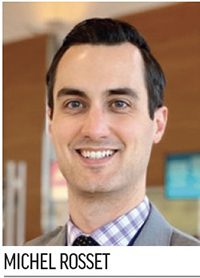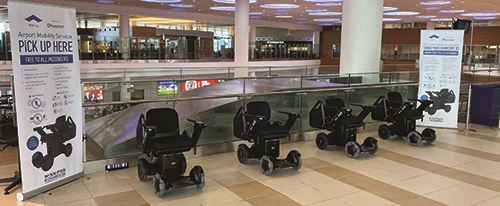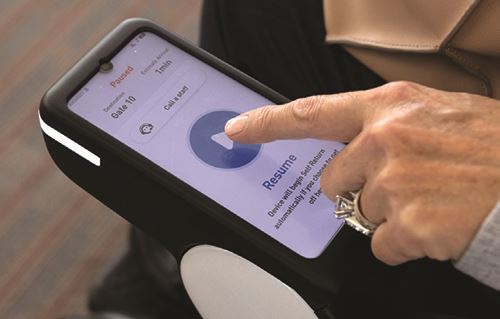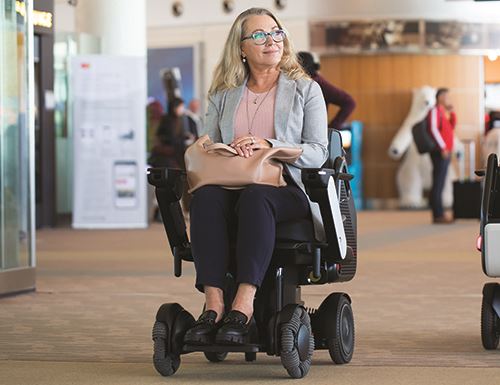After nearly three years of testing, Winnipeg Richardson International Airport (YWG) in Manitoba formally launched free autonomous wheelchair service to passengers in early December 2022, marking a first for North American airports.
After nearly three years of testing, Winnipeg Richardson International Airport (YWG) in Manitoba formally launched free autonomous wheelchair service to passengers in early December 2022, marking a first for North American airports.
The innovative program may be a harbinger for the rest of the industry. The IATA Global Passenger Survey predicts that by 2038, one in three travelers will need some form of assistance. Motivated by such statistics and observations at the airport, Winnipeg Airports Authority partnered with WHILL (a mobility equipment supplier) and Scootaround (a related rental service) to initiate the process of bringing autonomous wheelchair service to YWG.
“The work being done today at Winnipeg Richardson International Airport will help us meet the future needs of the community,” explains Nick Hays, president and chief executive officer of Winnipeg Airports Authority.
|
Project: Autonomous Wheelchair Program Location: Winnipeg (MB) Richardson Int’l Airport Provider: WHILL/Scootaround Trials: Dec. 2019–Dec. 2022 Scope: Self-driving wheelchairs transport travelers on pre-determined routes from check-in through security checkpoint to their departure gates; passengers can pause the ride to stop at restrooms, concessions, etc. Current Fleet: 4 wheelchairs Passenger Feedback: During final trial, 97% of users rated overall experience as excellent or very good; 99% said they would use the service again Other Airport Trials: Cincinnati/Northern Kentucky Int’l; Dallas Fort Worth Int’l; George Bush Intercontinental; Gerald R. Ford Int’l; Hartsfield-Jackson Atlanta Int’l; San Jose Mineta Int’l; Toronto Pearson Int’l; etc. |
Geography played a big part in YWG offering passengers “next-gen wheelchairs.” Although WHILL is headquartered in Tokyo, it has a head office in Winnipeg. When the company wanted to test its new autonomous equipment in a large North American airport, YWG was a natural choice. The partnership began in 2019 and came to commercial fruition at the end of last year.
The project began as a North American feasibility test but has since evolved to explore more ideal service use cases. “The addition of their innovative autonomous mobility device as a fully available service is another example of our commitment to providing a more accessible and inclusive environment,” says Hays. “We’re excited to see our partnership with WHILL continue to grow to help meet the evolving needs of travelers.”
Program Roots
WHILL first introduced its autonomous wheelchair program at Haneda Airport (Tokyo International) in 2020, and all major airports in Japan now offer the service. Kerry Renaud, chief executive officer for WHILL North America, reports that the company’s autonomous equipment provided more than 10,000 rides in December 2022 at Haneda Airport. The program is also in use at two other major Japanese airports: Narita International and, most recently, Kansai International.
The autonomous fleet at Haneda has more than 25 wheelchairs. When Renaud visited the airport in December 2022, all of them were in use. “It was almost as if the system had always been there,” he relates. “People are familiar with it, and all of the devices were being utilized.” That is the hope for the program in North America as well.
 Renaud previously worked on the rental side of the business at Scootaround in Winnipeg for about 17 years, eventually ascending to the position of chief executive officer. In 2018, WHILL acquired Scootaround, and Renaud became chief executive officer for WHILL and Scootaround North America.
Renaud previously worked on the rental side of the business at Scootaround in Winnipeg for about 17 years, eventually ascending to the position of chief executive officer. In 2018, WHILL acquired Scootaround, and Renaud became chief executive officer for WHILL and Scootaround North America.
Forging a Partnership
Michel Rosset, communications manager for Winnipeg Airports Authority, explains that YWG is intent on creating a seamless, enjoyable and more inclusive, accessible experience for all of its travelers. To that end, it has been working with WHILL and Scootaround to help develop and refine their innovative technology. Initial testing at the airport began in 2019 and included the post-security area leading to a few gates. Through trials and additional growth in the autonomous technology, the program’s service area has grown tremendously. “It really gave us hands-on access to developing the program as a prototype for the rest of North America,” Renaud remarks.
Rosset foresees global applications for WHILL’s forward-thinking service. “The things that they’ve developed and learned and grown with this technology have the potential to be implemented in airports all over North America and all over the world,” he relates. “So we’re proud to partner, and we’re proud to have that little homegrown success story.”
Once the scope of the service at YWG was determined in 2019, WHILL worked with the Airports Authority to create a computerized LIDAR map of the desired service areas in the terminal building—including key public landside spaces, the domestic and international security checkpoint and secure airside spaces. Crews used a 3-D scanner to capture data about where all hard, fixed items are in the terminal. This allows the wheelchairs to avoid seating banks, walls and other structures. The company’s first-generation autonomous chairs used a combination of stereo cameras and LIDAR sensors, and the cameras would sometimes “read” shadows as objects (or moved objects). When developing the second-generation chairs
that are now in use, WHILL will only use LIDAR sensors to
eliminate this issue.
After the mapping process was complete, WHILL’s technical staff drove the autonomous devices to create designated pathways, and then set the goal locations at various gates. Finally, the team executed user trials to validate the scope of the service. The airport issued security passes and allowed after-hours access as needed, and also provided a place to store the wheelchairs and charge their batteries. The Airports Authority and WHILL conducted three full trials to help refine the program and its features.
Expanding Service
When the program testing started in 2019, the chairs were only able to transport passengers from the security checkpoint to their gates. Now, service is available from the check-in counter through security and to the gates. “Through multiple trials and mapping and so forth, we were able to create the service as it is today, and it really has grown,” Rosset remarks.
Once a passenger arrives at the gate and transfers to gate seating, the wheelchair detects that the user has disembarked and starts a 60-second countdown. After the countdown is complete, the chair returns to a staging area near the check-in counters for the next user. Currently, YWG has four autonomous wheelchairs, and the service is available on the domestic and international sides of the airport.
Passengers can request a chair in advance or after they check their bags. A WHILL representative is stationed onsite to help coordinate with the Airports Authority, teach passengers how to use the service and address technical issues that may arise.

The wheelchairs follow predetermined paths to users’ gates, but passengers can pause the ride along that path to use the restroom, shop or get something to eat. Rosset reports that it is great seeing the service in action because it gives passengers greater control of their travel experience and eliminates the need for airport staff to push wheelchairs. “The traveler didn’t have that independence of going to the washroom or going to shops or visiting parts of the terminal they wanted to see,” Rosset emphasizes. “So this is working towards greater independence and a more accessible environment that we strive every day to provide.”
The ultimate vision is to offer the service from curb to gate. Autonomous wheelchairs would meet passengers at the curb, take them to their check-in counter, through the security checkpoint, to services or shops in the terminal and finally to their gates for boarding. Currently, WHILL is developing the technology to allow users at YWG to go to any post-security shop or restaurant (not just those along the predetermined paths). “As the technology continues to grow, we’re working to expand it more and more and offer these services,” says Rosset.
Authority and Airport Involvement
Renaud describes the program as turnkey. WHILL provides the autonomous wheelchairs, a tablet-based fleet management system, instructional banners explaining the service, floor stickers that act as drive path indicators and location markers to localize the device in the service area. Every chair also comes with two batteries and a charger.
WHILL’s fleet management system allows an on-site company representative to track the wheelchairs on a mobile tablet and ensure they are all working as intended. If any issues arise or a chair’s battery level drops below 20%, the operational dashboard automatically notifies the WHILL representative. At YWG, the representative typically doesn’t have to replace a battery in an eight-hour shift. Because each chair comes with two batteries, PHL can essentially run chairs 24/7 by swapping out their batteries when needed. At Haneda, WHILL typically swaps batteries out every six to seven hours.

Knowing that every airport has unique facilities and service challenges, WHILL uses knowledge gleaned from its current programs and trials to develop a variety of operational procedures. Renaud says that this practical experience allows the company to seamlessly introduce its autonomous wheelchair program into any airport and customize the service to what works best in each environment.
The ideal scenario for WHILL in the United States and Canada is to incorporate the service into existing wheelchair push contracts. Renaud considers the approach being taken by Winnipeg Airports Authority forward thinking and cooperative. “They really took the onus to introduce the service, and we’ve actually put one of our own staff members there on a full-time basis,” he says. The company representative is on hand during peak travel periods at YWG, assisting users through the security checkpoint and then on to their gates as needed. Renaud notes that YWG is unique because it allows the wheelchairs to go through security checkpoints.
Wheelchair-related service models vary significantly from airport to airport, he adds. Sometimes, the airport authority runs the program; elsewhere, airlines are responsible; and in other cases, a third-party company is contracted to provide wheelchair assistance. WHILL’s model has embraced all three scenarios.
Currently, the company is working to educate U.S. airports and airlines about the benefits of its offerings. In particular, it would like to incorporate autonomous wheelchairs into existing mobility assistance programs. Renaud emphasizes that WHILL can work with any service model—it will provide full-time on-site assistance, designate and train airport or airline personnel to administer the program, or work with existing third-party contractors by providing technology and resources to integrate the autonomous service into their existing program.
During the trial at YWG, Airports Authority officials felt it was important to incorporate an ambassador to support training and help users start the wheelchair devices and feel comfortable getting in and out of them. The WHILL/Scootaround representative has a tablet and can be called for assistance when needed. This position was created through the company’s service agreement with the Airports Authority.
Traveler Feedback
A primary focus of the trials at YWG was determining whether passengers felt comfortable and safe with the new technology. Rosset describes the feedback as overwhelmingly positive. “People liked the ability to be more independent and have this service available and not have to be pushed around,” he reports.
More travelers at YWG are becoming aware of the service as they see the autonomous wheelchairs moving throughout the airport on their designated paths—with or without riders. If another traveler is in a wheelchair’s path, it beeps, pauses and politely says, “Excuse me, can you move a little bit?” and then continues on its way.
“It’s catching the attention of everybody who travels to the airport, which is helping to raise that awareness of accessibility that we often refer to,” says Rosset.
Renaud reports that during the latest trial at YWG, 97% of users rated the overall experience as excellent or very good, and 99% said they would use the service again. Many passengers who used the service also mentioned that long walks to the gates at other airports present significant challenges to their mobility and physical comfort. In many cases, travelers asked how quickly they will see this service at other airports. “Passengers with reduced mobility are really looking for a reliable and consistent service to assist them through that airport,” Renaud concludes.
Challenges and Opportunities
Mapping the airport and “teaching” wheelchairs the locations of fixed items (and to adjust for shadows throughout the day) required technology and time. The project team encountered extra challenges when concessionaires would place signs or racks of merchandise outside their storefronts, and then pull them back inside to lock up at the end of the day while wheelchairs were still in service. “Wet floor” signs were another element that drove home the fact that YWG is a flexible environment.
“It was working with the developers and kind of learning as technology grew and matured for our environment,” Rosset remarks. “It wasn’t a big challenge, but it was an interesting one, for sure.”
Beyond the mapping process, WHILL worked to build awareness and educate users—both ongoing efforts. Renaud notes that as airports consider autonomous wheelchairs, there is some trepidation about potential risks and liability. “I think what we’re showing with Winnipeg is the fact that there really isn’t a risk factor,” he asserts. “Passengers are utilizing this program really effectively, and I think the risk side of it really kind of evaporates.”
On the cost side, Renaud says that WHILL can show airports that this is a significant customer service that is financially viable as well. Pricing for an autonomous wheelchair program varies depending on the number of units, the level of support WHILL provides (versus an existing operator) and the scope of service. Based on those requirements, WHILL develops a monthly fee—typically with a minimum two-year commitment—that covers mapping, device routing, testing, training, ongoing support, signage, software/feature updates, public relations support, etc. Renaud reports that in all cases that WHILL has run cost comparisons between its service and an existing traditional push service, WHILL has shown a positive return on investment for the operator.
Rosset notes that the industry in general needs to be more accessible in the future. “Over the next decade, airports need to grapple with serious demographic challenges, such as an aging population,” he advises.
For YWG, self-driving wheelchairs may prove to be a new way to provide more autonomy, independence and dignity to passengers who face physical barriers. “It’s part of being an airport for everybody—to be barrier-free, to be an accessible environment for any passenger—because we know each and every traveler is unique and so are their needs and requirements,” explains Rosset.
Project participants are optimistic that the pilot project will help YWG meet its accessibility/service goals and make travel more welcoming for all.

Renaud emphasizes that the service benefits travelers and airports. For passengers, it eliminates the need to rely on someone else to push them to their gate, and then being stuck there. It fosters independence for passengers to navigate through the airport, he adds. There are also tangible, commercial benefits for airports. “Now, these passengers can enjoy all the amenities,” he explains. “They can shop, they can move to the restaurants freely, they can circumvent the entire landscape of the airport by utilizing this kind of mobility assistance program.”
In some airports, WHILL augments its autonomous service with wheelchairs passengers can drive themselves. With this option, travelers don’t have to stick to designated autonomous routes.
Renaud lauds YWG for recognizing the current and future needs of passengers and working with WHILL to accommodate them. Especially at large airports, travelers need to be able to move efficiently to their gate in a reasonable amount of time. “We’re really appreciative of the fact that Winnipeg stepped up and stepped forward and enabled this first commercial application (in North America),” he remarks. “And it’s really our hope to be able to now take that to multiple other airports and utilize the success of the program in Winnipeg to show other airports what’s possible.”
Growing the Footprint
At YWG, the Airports Authority plans to offer more wheelchairs as usage increases and the autonomous technology continues to mature. It also looks forward to expanding the service from curb to gate, though this will require more time and work to map additional areas.
The COVID pandemic prompted WHILL to address YWG’s need for wheelchair assistance from the curbside to the check-in counter to comply with the new guidelines posed by the Canadian Government Accessibility Regulation. Since then, the team has been taking a phased approach and implemented service from check-in counters to departure dates as the first step.
Extending use of autonomous wheelchairs to elevators is a key next step. WHILL is currently working with the Airports Authority and its elevator maintenance providers to define the requirements of a system upgrade. “That’ll really open up a lot of other larger-scale airport requirements,” Renaud notes.
Expanding the current service to include the lower level at YWG will connect travelers to baggage claim and arrivals areas.
For WHILL, the ultimate objective at YWG was to prove the commercial viability of its new and unique service. “Our expectation is that this program is ready to roll out to conceivably every airport in the world—anywhere where there’s that kind of a demand, anywhere where passengers require some level of wheelchair assistance to circumnavigate the airport,” says Renaud.
Currently, the company is running additional trials at other North American airports and one in Europe. Renaud reports that after successful trials at several North American airports (see Facts and Figures box on Page 48), WHILL is in discussions about moving forward with full-time programs similar to YWG’s. The company also plans to work directly with airlines.




